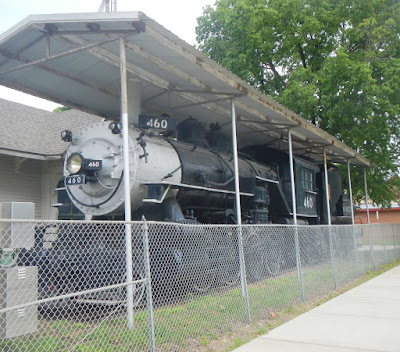We were closing in on the Kansas-Nebraska
state line but we had a few historic sites that we wanted to check out in
Marysville Kansas…
Marshall County once had over 100 rural
schools. Improved transportation eventually
made school consolidation possible. The
last rural school in the county closed in 1969.
Bommer School was moved to Marysville’s City Park from a rural site. It was originally painted white. It’s open for tourists to view in the summer.
Factoids:
·
Marshall County’s population peaked in
1900 with a census totaling 24,355 residents.
In 2010, the county’s census had dropped to 10,117. Marysville, with a population of approximately
3,295, is the county seat.
·
In May of 1879, an F4 tornado passed through
Marshall County. This tornado had a
damage path 800 yards wide, (almost a half mile), and 100 miles long. A total of 18 people were killed and 60 were
injured.
·
Marysville’s City Park also contains a ‘Soddy’,
the type of house made from sod that many early settlers first built on the
prairie.
Sitting just to the right of Bommer
School in Marysville’s City Park is Union Pacific Steam locomotive #460. This locomotive is a ‘Consolidated’ 2-8-0
type…so called because it has 2 leading wheels and the other 8 are consolidated
in one grouping. From its introduction
in 1866 and well into the early twentieth century, the 2-8-0 design was
considered to be the ultimate heavy freight locomotive. The 2-8-0’s forte was starting and moving
'impressive loads at unimpressive speeds' and its versatility gave the type its
longevity.
Production of the 2-8-0 type in the
United States totaled more than 33,000 locomotives, of which 12,000 were export
versions! The 2-8-0 S160 Class of the
United States Army Transportation Corps was built by American manufacturers and
was designed for use in Europe for heavy freight work during World War II. A total of 2,120 of this class were built and
they worked on railroads all across the world.
I couldn’t find any reference to events
surrounding this locomotive and it’s completely fenced in. It was donated to the city by Union Pacific
Railroad in 1956.
Factoid:
·
About 50 percent of the Marysville's fox
squirrels are coal black…an unusual variation. Some squirrels show black patterns intermixed
with normal coloration. The best place
to look for them is in the City Park.
This old Union Pacific Depot is hidden
behind the locomotive and it’s tender. It was moved to this site in Marysville from Beattie Kansas,
a small town in Marshall County with a population of about 200. The railroad first came to Beattie in 1870. It was known as the St. Joseph and Denver City
Railroad and later as the St. Joseph and Grand Island Railroad. There were many other name changes over the
years... This depot dates back to 1901.
Factoid:
·
In order to get the railroad to come
through Beattie, the two primary landholders who owned the town site agreed to
give the railroad about half of the lots set out for the town’s development.
Beattie still had rail service in late
1938 as I found a Union Pacific schedule on-line that showed 2 eastbound and 2
westbound “Motorcars” daily. They ran
from Seneca Kansas to Marysville, a distance of about 32 miles, with stops along
the way. These self-propelled rail motorcars
were much more commonly used in more heavily populated areas of the USA.
I noted that the Union Pacific had bought
20 of these rail motor cars from the McKeen Motor Car Company, which was basically
an offshoot of the railroad itself. The
company was charged with the development of a less expensive way to move
passengers between smaller towns. McKeen
Motor Cars were never that successful due to inadequate motors but similar
manufacturers subsequently improved on the concept.
Just click on any of the photos to
enlarge them…
Thanks for stopping by for a visit!
Take Care, Big Daddy Dave





I just started to read blogs again – as I was away and also had problems with an erratic computer (I hope it won’t crash again.) I looked at all your great photos and all the yummy meals you showed us. I especially liked the vintage pictures of your family – they were handsome people and your great-grandma was quite attractive.
ReplyDeleteFor the last week or so I have been reading about the Westward Journey. Because of my journey west I picked up one of my husband’s books on women’s diaries going to California and mostly Oregon and have been reading a lot. The book is on 90 diaries of women going west from 1841 to 1862. It is fascinating and I am learning a lot – for example I did not know that most of these people had money as I always thought they were poor folks going west for a better life – no so, most had money and wanted more land (the poor ones came later, and by train, or during the Dust Bowl.) There are also many pictures of these women, all dressed very nicely (and some expensively.) My husband has a large library on the West so I’ll be reading more. But for better understanding of the times I also had to read on American Indians of the time, and that is also surprising me a lot, in a very sad way as what I believed was false (very few pioneers were ever attacked…). I’ll have a post on all this when I am finished reading. Your pictures on your last posts were of so much interest to me and I could not believe that wagon traces could still be seen in the ground.
I am loving the little red school house. Great shot! Schools have come a long way since then. I also would love to see a black squirrel again. I've only seen one.
ReplyDeleteSam
I love the first picture what lovely and cute little school house!!
ReplyDelete